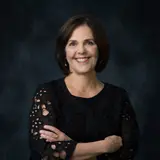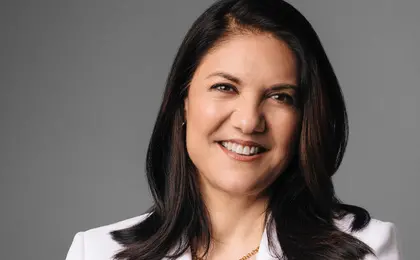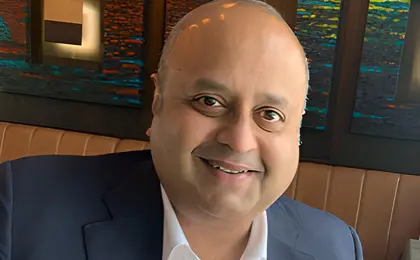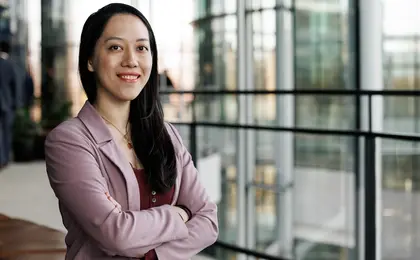
Paula J. Volent ’97
MBA
Vice President and Chief Investment Officer, The Rockefeller University
By Rebecca Beyer
By the time Paula J. Volent ’97 arrived at the Yale School of Management, she had already built a successful career as a paper conservator, including as a fellow at the National Gallery of Art in Washington, DC, and running her own studio in Venice, California. Over the years, she worked with artists ranging from Ellsworth Kelly and David Hockney to Richard Serra.
At Yale SOM, Volent hoped to learn enough about finance and investing to help museums grow their endowments. Early on, she knocked on the door of David Swensen, the legendary investor who, until his death in 2021, ran the Yale Investments Office.
“He looked at my résumé and said, ‘There’s not one thing that applies to what we do in this office, but come on in,’” she remembers. “David loved to teach people.”
Volent stayed on at the Investments Office throughout her time at SOM and beyond, starting out as an intern and eventually taking on more substantive work. By the time she left in 2000, she had helped Swensen write his first book, Pioneering Portfolio Management.
Volent could write her own book. In 2021, she joined Rockefeller University as vice president and chief investment officer. Before that, she spent more than two decades at Bowdoin College, including as senior vice president for investments and chief investment officer. In that time, she grew Bowdoin’s endowment from $465 million to about $3 billion, outperforming every Ivy League institution—including Yale—for many years. In her office, she keeps a framed letter from Swensen in which he quotes Leonardo da Vinci: “Poor is the pupil who does not surpass the teacher.”
Swensen saw his work for Yale as mission driven, and Volent takes a similar view, noting that she relied on financial aid for her own education. “I really wanted to pay that back,” she says. “I want to make money and be part of something whose mission goes beyond me. I think I learned that at Yale.”
Volent grew up in Worcester, Massachusetts, and Maine. Neither of her parents went to college, and they hoped she would enroll at a secretarial school. Instead, Volent, who had always loved art, started an undergraduate career at Emerson College before transferring to the University of New Hampshire, where she studied chemistry and art history. After working at Bowdoin as a curatorial assistant, and interning at the Williamstown Conservation Laboratory, she earned her master’s degree in art history and a certificate in art conservation at New York University’s Institute of Fine Arts.
She was taking a finance class at the University of California, Los Angeles to build her skills as a business owner when her professor brought an SOM admissions officer to her Venice studio (Volent was working on a De Kooning drawing at the time). Volent had not considered getting an MBA, but she applied “on a whim” and got in, deferring for a year to work at the National Gallery.
In addition to her time with Swensen, for whom she also worked as a teaching assistant, she cites courses with Professors Roger G. Ibbotson, Ken French, and William N. Goetzmann as particularly influential.
“Will Goetzmann’s class on investing changed my life,” she says. “I started to understand how you look for inefficiencies, and how the whole portfolio fits together. Little by little, I fell in love with investing.”
Volent sees parallels between her work as a conservator and her work in finance.
Before working with a piece of art, “you have to really look at it and do a lot of testing,” she explains. “Then you do your treatment. That is very similar to what I do in an investment office, with lots and lots of work on investment opportunities, thinking about what could go wrong and what would I do if it did.”
Volent built Bowdoin’s investment office “from scratch,” applying a lot of what she had learned from Swensen, including diversifying the college’s portfolio into alternative investments such as venture capital and real estate, among other asset classes. Because of the growth in the school’s endowment, the institution has been able to stay “need blind,” meaning it does not consider a person’s ability to pay in the admissions process.
Every institution has different needs and risk tolerance, she explains. Because Rockefeller does not charge tuition, Volent must make sure the university has adequate liquidity. “It’s a very different balance sheet,” she says.
Volent says she draws on lessons from SOM regularly, including from a class on decision-making that she took with Professor Barry Nalebuff. The class focused on how to approach decisions by considering best and worst possible outcomes. “I do a decision tree probably every week,” she says.
Volent has maintained her connections to the art world as a collector and as a member of the boards of the Andy Warhol Foundation and the Skowhegan School of Painting and Sculpture, among other positions.
She also remains an active member of the Yale SOM community, serving as vice chair of the school’s Board of Advisors and as a guest lecturer in the Master’s Degree in Asset Management program, co-founded by Swensen. In October, she received the Leadership in Business and Society award from the school’s New York City alumni chapter.
“I had the opportunity to work with amazing people at Yale and am still very close with many people in my class,” she says. “Yale changed my life.”
Related Profiles

Mary Ellen Iskenderian ’86

Vikram Wagh ’04

